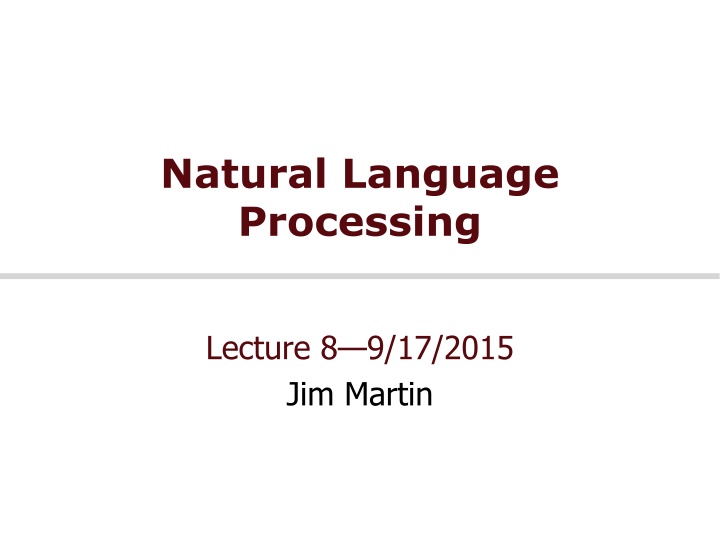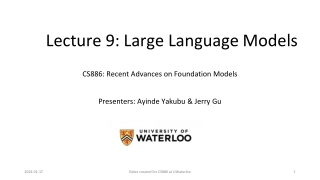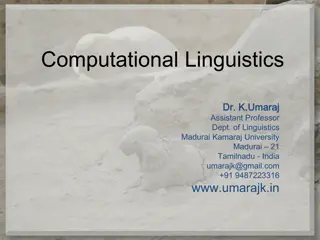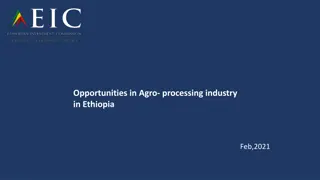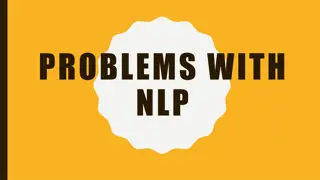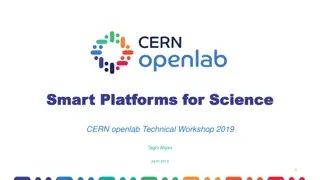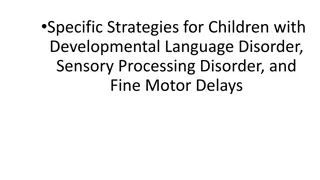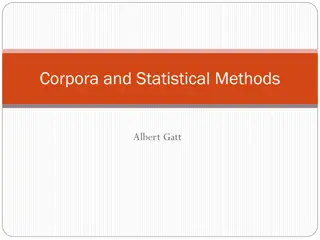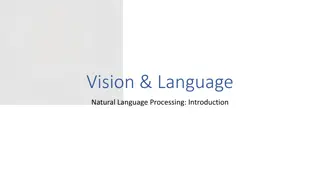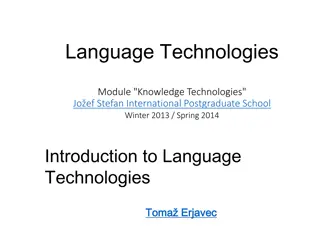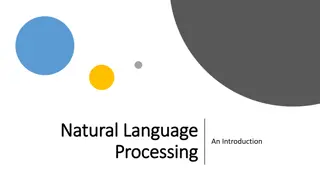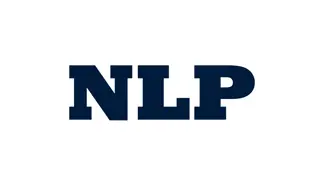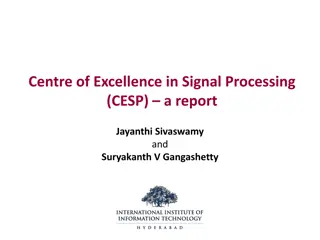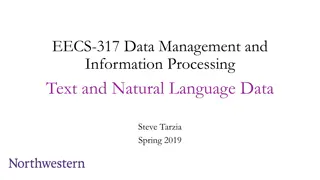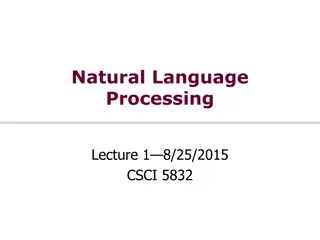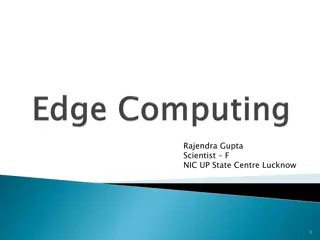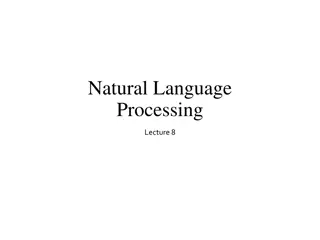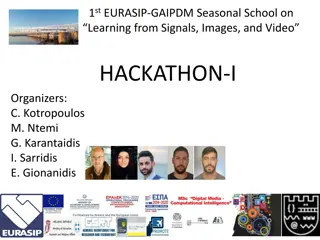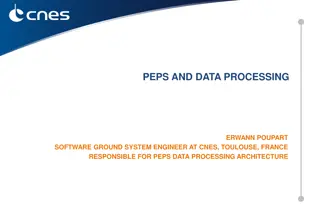Natural Language Processing
Explore the intricate world of Natural Language Processing through lectures covering topics such as Kneser-Ney Smoothing, POS Tagging, HMM models, Absolute Discounting, and more. Dive into the fundamentals of speech and language processing with a focus on understanding probabilities, smoothing techniques, and bigram counts. Enhance your knowledge with practical examples and insights shared by Jurafsky and Martin.
Download Presentation

Please find below an Image/Link to download the presentation.
The content on the website is provided AS IS for your information and personal use only. It may not be sold, licensed, or shared on other websites without obtaining consent from the author.If you encounter any issues during the download, it is possible that the publisher has removed the file from their server.
You are allowed to download the files provided on this website for personal or commercial use, subject to the condition that they are used lawfully. All files are the property of their respective owners.
The content on the website is provided AS IS for your information and personal use only. It may not be sold, licensed, or shared on other websites without obtaining consent from the author.
E N D
Presentation Transcript
Natural Language Processing Lecture 8 9/17/2015 Jim Martin
Today Finish up smoothing Kneser-Ney example HMMs POS tagging example Basic HMM model Decoding Viterbi 3/7/2025 2 Speech and Language Processing - Jurafsky and Martin
Absolute Discounting Just subtract a fixed amount from all the observed counts (call that d). Redistribute it proportionally based on observed data 3/7/2025 3 Speech and Language Processing - Jurafsky and Martin
Absolute Discounting w/ Interpolation discounted bigram Interpolation weight PAbsoluteDiscounting(wi|wi-1)=c(wi-1,wi)-d +l(wi-1)P(w) c(wi-1) unigram 4
Kneser-Ney Smoothing Better estimate for probabilities of lower-order unigrams! Shannon game: I can t see without my reading___________? Francisco is more common than glasses but Francisco frequently follows San So P(w) isn t what we want Francisco glasses
Kneser-Ney Smoothing Pcontinuation(w): How likely is a word to appear as a novel continuation? For each word, count the number of bigram types it completes PCONTINUATION(w) {wi-1:c(wi-1,w)>0} 3/7/2025 6 Speech and Language Processing - Jurafsky and Martin
Kneser-Ney Smoothing Normalize that by the total number of word bigram types to get a true probability {wi-1:c(wi-1,w)>0} {(wj-1,wj):c(wj-1,wj)>0} PCONTINUATION(w)=
Kneser-Ney Smoothing PKN(wi|wi-1)=max(c(wi-1,wi)-d,0) +l(wi-1)PCONTINUATION(wi) c(wi-1) is a normalizing constant; the probability mass we ve discounted d l(wi-1)= {w:c(wi-1,w)>0} c(wi-1) The number of word types that can follow wi-1 the normalized discount 8
Bigram Counts 3/7/2025 9 Speech and Language Processing - Jurafsky and Martin
BERP Let s look at chinese food . We ll need: Count( chinese food ) Count( chinese ) P_continuation( food ) Count of bigrams food completes Count of all bigram types Count of bigrams that chinese starts 82 158 110 9421 17 3/7/2025 10 Speech and Language Processing - Jurafsky and Martin
BERP Let s look at chinese food . We ll need: Count( chinese food ) Count( chinese ) P_continuation( food ) Count of bigrams food completes Count of all bigram types Count of bigrams that chinese starts 3/7/2025 11 Speech and Language Processing - Jurafsky and Martin
Break 3/7/2025 12 Speech and Language Processing - Jurafsky and Martin
Word Classes: Parts of Speech 8 (ish) traditional parts of speech Noun, verb, adjective, preposition, adverb, article, interjection, pronoun, conjunction, etc Called: parts-of-speech, lexical categories, word classes, morphological classes, lexical tags... Lots of debate within linguistics about the number, nature, and universality of these We ll completely ignore this debate. 3/7/2025 13 Speech and Language Processing - Jurafsky and Martin
POS Tagging The process of assigning a part-of-speech or lexical class marker to each word in a collection. WORD tag the koala put the keys on the table DET N V DET N P DET N 3/7/2025 14 Speech and Language Processing - Jurafsky and Martin
Penn TreeBank POS Tagset 3/7/2025 15 Speech and Language Processing - Jurafsky and Martin
POS Tagging Words often have more than one part of speech: back The back door = JJ On my back = NN Win the voters back = RB Promised to back the bill = VB The POS tagging problem is to determine the POS tag for a particular instance of a word in context Usually a sentence 3/7/2025 16 Speech and Language Processing - Jurafsky and Martin
POS Tagging Note this is distinct from the task of identifying which sense of a word is being used given a particular part of speech. That s called word sense disambiguation. We ll get to that later. backed the car into a pole backed the wrong candidate 3/7/2025 17 Speech and Language Processing - Jurafsky and Martin
How Hard is POS Tagging? Measuring Ambiguity 3/7/2025 18 Speech and Language Processing - Jurafsky and Martin
Two Methods for POS Tagging 1. Rule-based tagging 2. Stochastic 1. Probabilistic sequence models HMM (Hidden Markov Model) tagging MEMMs (Maximum Entropy Markov Models) 3/7/2025 19 Speech and Language Processing - Jurafsky and Martin
POS Tagging as Sequence Classification We are given a sentence (an observation or sequence of observations ) Secretariat is expected to race tomorrow What is the best sequence of tags that corresponds to this sequence of observations? Probabilistic view Consider all possible sequences of tags Out of this universe of sequences, choose the tag sequence which is most probable given the observation sequence of n words w1 wn. 3/7/2025 20 Speech and Language Processing - Jurafsky and Martin
Getting to HMMs We want, out of all sequences of n tags t1 tn the single tag sequence such that P(t1 tn|w1 wn) is highest. Hat ^ means our estimate of the best one Argmaxx f(x) means the x such that f(x) is maximized 3/7/2025 21 Speech and Language Processing - Jurafsky and Martin
Getting to HMMs This equation should give us the best tag sequence But how to make it operational? How to compute this value? Intuition of Bayesian inference: Use Bayes rule to transform this equation into a set of probabilities that are easier to compute (and give the right answer) 3/7/2025 22 Speech and Language Processing - Jurafsky and Martin
Using Bayes Rule Know this. 3/7/2025 23 Speech and Language Processing - Jurafsky and Martin
Likelihood and Prior 3/7/2025 24 Speech and Language Processing - Jurafsky and Martin
Two Kinds of Probabilities Tag transition probabilities p(ti|ti-1) Determiners likely to precede adjs and nouns That/DT flight/NN The/DT yellow/JJ hat/NN So we expect P(NN|DT) and P(JJ|DT) to be high Compute P(NN|DT) by counting in a labeled corpus: 3/7/2025 25 Speech and Language Processing - Jurafsky and Martin
Two Kinds of Probabilities Word likelihood probabilities p(wi|ti) VBZ (3sg Pres Verb) likely to be is Compute P(is|VBZ) by counting in a labeled corpus: 3/7/2025 26 Speech and Language Processing - Jurafsky and Martin
Example: The Verb race Secretariat/NNP is/VBZ expected/VBN to/TO race/VB tomorrow/NR People/NNS continue/VB to/TO inquire/VB the/DT reason/NN for/IN the/DT race/NN for/IN outer/JJ space/NN How do we pick the right tag? 3/7/2025 27 Speech and Language Processing - Jurafsky and Martin
Disambiguating race 3/7/2025 28 Speech and Language Processing - Jurafsky and Martin
Disambiguating race 3/7/2025 29 Speech and Language Processing - Jurafsky and Martin
Example P(NN|TO) = .00047 P(VB|TO) = .83 P(race|NN) = .00057 P(race|VB) = .00012 P(NR|VB) = .0027 P(NR|NN) = .0012 P(VB|TO)P(NR|VB)P(race|VB) = .00000027 P(NN|TO)P(NR|NN)P(race|NN)=.00000000032 So we (correctly) choose the verb tag for race 3/7/2025 30 Speech and Language Processing - Jurafsky and Martin
Hidden Markov Models What we ve just described is called a Hidden Markov Model (HMM) This is a kind of generative model. There is a hidden underlying generator of observable events The hidden generator can be modeled as a network of states and transitions We want to infer the underlying state sequence given the observed event sequence 3/7/2025 31 Speech and Language Processing - Jurafsky and Martin
Hidden Markov Models States Q = q1, q2 qN; Observations O= o1, o2 oN; Each observation is a symbol from a vocabulary V = {v1,v2, vV} Transition probabilities Transition probability matrix A = {aij} aij= P(qt= j |qt-1=i) 1 i,j N Observation likelihoods Output probability matrix B={bi(k)} bi(k)= P(Xt=ok|qt=i) Special initial probability vector pi= P(q1=i) 1 i N 3/7/2025 32 Speech and Language Processing - Jurafsky and Martin
HMMs for Ice Cream You are a climatologist in the year 2799 studying global warming You can t find any records of the weather in Baltimore for summer of 2007 But you find Jason Eisner s diary which lists how many ice-creams Jason ate every day that summer Your job: figure out how hot it was each day 3/7/2025 33 Speech and Language Processing - Jurafsky and Martin
Eisner Task Given Ice Cream Observation Sequence: 1,2,3,2,2,2,3 Produce: Hidden Weather Sequence: H,C,H,H,H,C, C 3/7/2025 34 Speech and Language Processing - Jurafsky and Martin
HMM for Ice Cream 3/7/2025 35 Speech and Language Processing - Jurafsky and Martin
Ice Cream HMM Let s just do 131 as the sequence How many underlying state (hot/cold) sequences are there? HHH HHC HCH HCC CCC CCH CHC CHH How do you pick the right one? Argmax P(sequence | 1 3 1) 3/7/2025 36 Speech and Language Processing - Jurafsky and Martin
Ice Cream HMM Let s just do 1 sequence: CHC Cold as the initial state P(Cold|Start) .2 .5 Observing a 1 on a cold day P(1 | Cold) .4 Hot as the next state P(Hot | Cold) .4 Observing a 3 on a hot day P(3 | Hot) .3 Cold as the next state P(Cold|Hot) .0024 .5 Observing a 1 on a cold day P(1 | Cold) 3/7/2025 37 Speech and Language Processing - Jurafsky and Martin
POS Transition Probabilities 3/7/2025 38 Speech and Language Processing - Jurafsky and Martin
Observation Likelihoods 3/7/2025 39 Speech and Language Processing - Jurafsky and Martin
Question If there are 30 or so tags in the Penn set And the average sentence is around 20 words... How many tag sequences do we have to enumerate to argmax over in the worst case scenario? 3020 3/7/2025 40 Speech and Language Processing - Jurafsky and Martin
